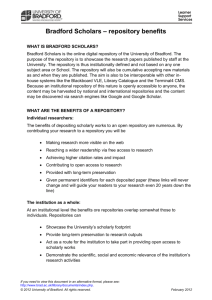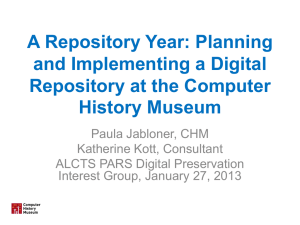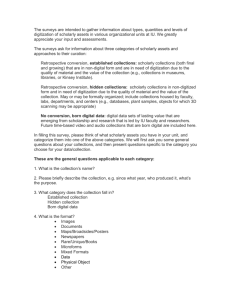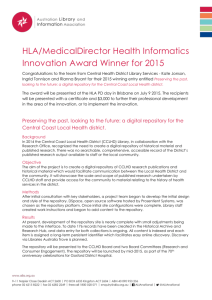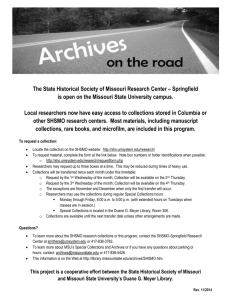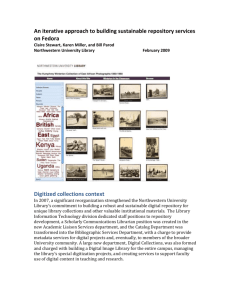CurateND_UseCase_RepoPlat_20151203
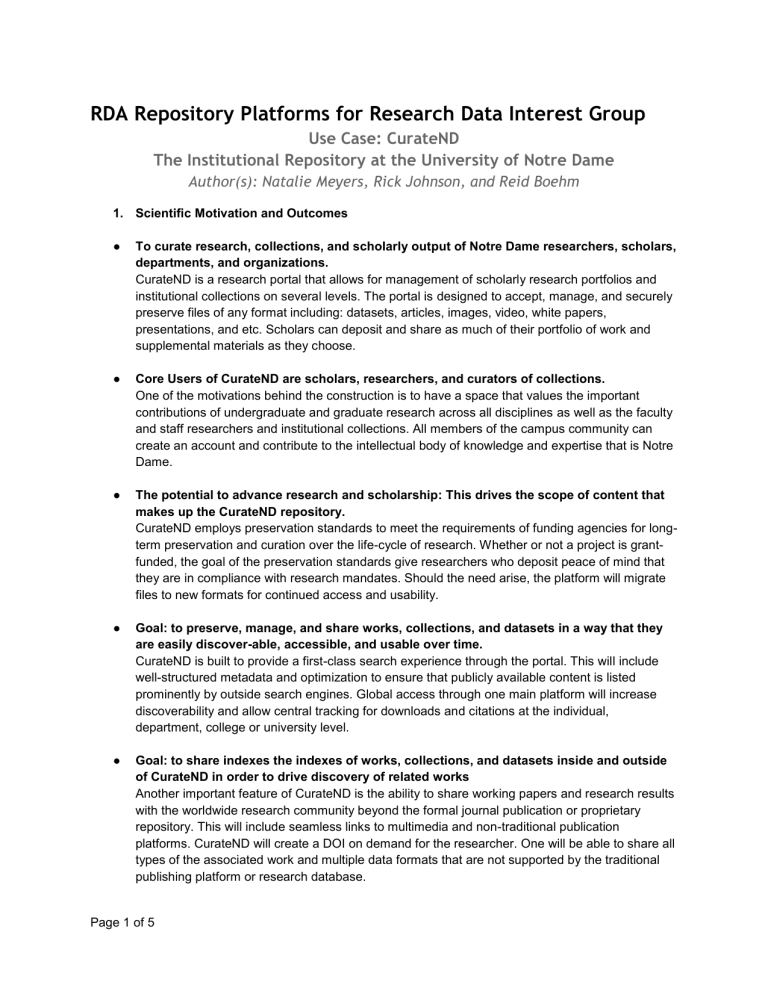
RDA Repository Platforms for Research Data Interest Group
Use Case: CurateND
The Institutional Repository at the University of Notre Dame
Author(s): Natalie Meyers, Rick Johnson, and Reid Boehm
1. Scientific Motivation and Outcomes
● To curate research, collections, and scholarly output of Notre Dame researchers, scholars, departments, and organizations.
CurateND is a research portal that allows for management of scholarly research portfolios and institutional collections on several levels. The portal is designed to accept, manage, and securely preserve files of any format including: datasets, articles, images, video, white papers, presentations, and etc. Scholars can deposit and share as much of their portfolio of work and supplemental materials as they choose.
● Core Users of CurateND are scholars, researchers, and curators of collections.
One of the motivations behind the construction is to have a space that values the important contributions of undergraduate and graduate research across all disciplines as well as the faculty and staff researchers and institutional collections. All members of the campus community can create an account and contribute to the intellectual body of knowledge and expertise that is Notre
Dame.
● The potential to advance research and scholarship: This drives the scope of content that makes up the CurateND repository.
CurateND employs preservation standards to meet the requirements of funding agencies for longterm preservation and curation over the life-cycle of research. Whether or not a project is grantfunded, the goal of the preservation standards give researchers who deposit peace of mind that they are in compliance with research mandates. Should the need arise, the platform will migrate files to new formats for continued access and usability.
● Goal: to preserve, manage, and share works, collections, and datasets in a way that they are easily discover-able, accessible, and usable over time.
CurateND is built to provide a first-class search experience through the portal. This will include well-structured metadata and optimization to ensure that publicly available content is listed prominently by outside search engines. Global access through one main platform will increase discoverability and allow central tracking for downloads and citations at the individual, department, college or university level.
● Goal: to share indexes the indexes of works, collections, and datasets inside and outside of CurateND in order to drive discovery of related works
Another important feature of CurateND is the ability to share working papers and research results with the worldwide research community beyond the formal journal publication or proprietary repository. This will include seamless links to multimedia and non-traditional publication platforms. CurateND will create a DOI on demand for the researcher. One will be able to share all types of the associated work and multiple data formats that are not supported by the traditional publishing platform or research database.
Page 1 of 5
2. Functional Description
Together these four diagrams make up the flow of content into and out of the CurateND repository environment. Each diagram illustrates a different function that fulfils a specific repository component.
● The file and metadata upload process allows the user to access a patron oriented deposit interface through their browser. The user is able to have control over their individual documents in the system. Dragonfly handles the images and attachments that are uploaded and the MySQL database stores persistent identifiers for the content.
● Ingest of collections and large amounts of content also use the deposit interface in conjunction with a batch ingest infrastructure. The repository platform is Fedora and the content is ready to be accessed via the additional search platform SOLR. Also, content is preserved in a fixed state where files are bundled and copied to tape storage.
● Discovery of content within CurateND is a result of the communication between the repository, the search platform, and the user’s browser which may mean searching directly from the
CurateND search interface or from an external search such as Google Scholar.
Page 2 of 5
● Dissemination of materials is a result of the communication between the repository platform, an authorization proxy, and the user’s browser. This ensures that people with certain permissions can access and download certain content and protects other content when researchers deem it sensitive. Some actions that can be performed within the repository are limited to those who are affiliated with the university and others are open to any visitor. This functional element manages this type of material exchange between the user and the content in CurateND.
3. Achieved Results
CurateND started operating in early 2015 and is currently in the process of shaping and extending the existing interface to reflect all the goals and objectives mentioned above. The repository is doing well in managing and sharing the electronic theses and dissertations and it is slowly growing and expanding as other researchers are beginning to deposit single works and larger projects. There are finding aids, articles, datasets, images, maps, and several collections. The repository is able to accept these multidimensional materials and the foundation is well developed in which we will expand services and refine usability to accommodate different needs and further goals.
Several notable achievements include:
● A clearly defined set of policies for the repository and user’s ability to make an informed decision regarding copyright and access permissions on the content that they have uploaded.
● The ability for a DOI to be assigned to materials on the user’s behalf.
● Users are able to create a group which allows them to collaborate and share recognition for content as a unit.
● An average level of quality discoverability exists through external searches on Google Scholar and from the search interface.
● Storage and preservation plans are in place for the future. There are necessary changes being made in the storage element of the system as well as migration to Fedora 4 and the development team has identified processes for quality long-term storage.
● Connections exist with open systems and repositories such as the Open Science Framework that will allow future partnerships and content referrals between interfaces.
● A team of individuals distributed in multiple departments within the library work together to field questions from users and develop solutions to issues as they occur.
● A connection is established to the service PlumX Metrics in preparation to provide data about researchers’ external search, citation, and popularity of researcher’s body of work over time.
Future goals or plans for CurateND beyond the current implementation include:
● To ingest and highlight special collections within the repository that are currently in the process of being documented and organized for maximum visualization and discoverability.
● To more clearly define ontological properties of the system to allow for best possible search and retrieval.
● To create a layer to the interface that allows for browsability of the full repository for users both internal and external to the university.
● To better define the search interface elements which will correct some current issues with searchability.
● To migrate existing framework to Fedora 4.
● To implement internal analytics tools that will show popular searches, and most sought after materials and share this data with the students, faculty, staff, researchers, and scholars..
Page 3 of 5
● To foster connections with other repository environments and collections that partner with the university to share and aggregate materials. Examples include the Open Science Framework,
Hathitrust, and the DPLA.
● To continue to refine discoverability from search engines such as Google Scholar.
● To increase familiarity and use within the university community.
4. Requirements
Requirement Description Motivation from Use
Case
Importance (1 - very important 1 to 5 - not at all important 2 )
Maintain digital content accessibility overtime
1 Files need to be converted to the most accessible formats and use of proprietary and legacy types are reviewed on a case by case basis.
Many materials are in formats that may become obsolete -
CurateND needs to have consistent sustainable formats available.
A team of developers and content management specialists work together for the life of the repository to create and maintain a custom platform with flexible structure.
User interface, features, and functionality should be updated over time to match the requirements and expectations of current researchers.
Adapt ease of browsing, searching by current researchers over time.
1
Use of external analytics services such as PlumX and internal monitoring of user activity with consistent updates to stakeholders.
This allows the repository to track and share usage and activity related to profiles, collections, datasets, and other items in CurateND
Demonstrate impact of
Notre Dame collections, researchers, scholars, and organizations to research and scholarship
Make the ingest process easy and open to all associated with the University of Notre
Dame allowing for many content types to be deposited.
Opening up many barriers to entry into the repository allows for the curation of unpublished materials and supports linking to published works in other places.
Show wider picture of impact including external community activity like conferences, social media, scholarly forums, and other
3
2
1 1= Feature Exists/Complete in existing system
2 5= Feature not yet implemented, low priority
Page 4 of 5
forms of scholarly communication
Curates metadata indices of collections as well as researchers and scholars work
This allows the content to be harvestable by external search engines to increase usage and impact.
Increase visibility and impact of collections by
Making items more discoverable and accessible
1
Create within the repository- special collection views or digital exhibits
By separating these components it preserves the body of work both within the context of the University and as an entity with special contextual importance
Curating rare, unknown collections, to increase their impact and to bring focus to the unique attributes and scholarly community that represent the
University of Notre
Dame as institution of higher learning with a rich history
2
Creating holistic view of scholarly activity of researchers, scholars, or collections within a department or other institutional component
To be holistic these views should include campus institutes, centers, library departments, and branch libraries
Demonstrate and increase impact of academic departments and areas by driving traffic to their materials based on departmental affiliation
3
Page 5 of 5

